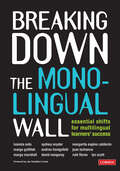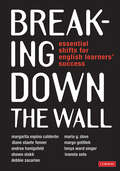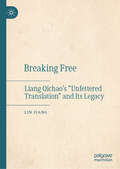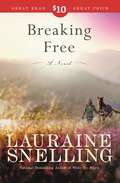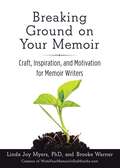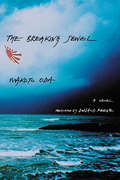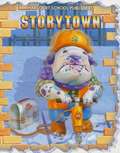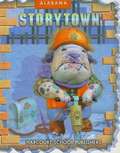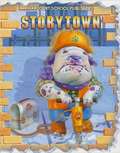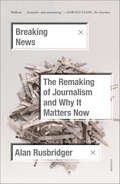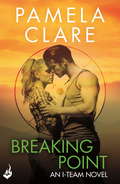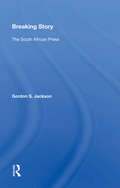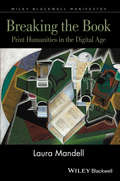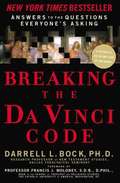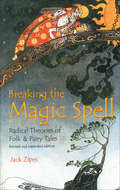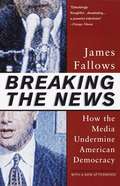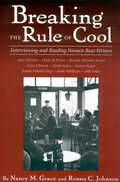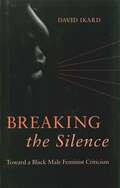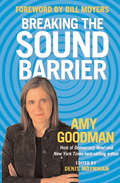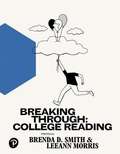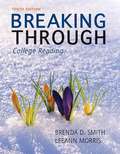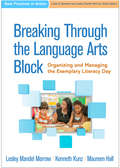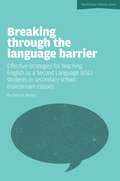- Table View
- List View
Breaking Down the Monolingual Wall: Essential Shifts for Multilingual Learners′ Success
by Margarita Espino Calderon Margo Gottlieb Ivannia Soto Sydney Cail Snyder Andrea Honigsfeld Joan R. Lachance Margarita Marshall David Nungaray Rubí Flores Lyn ScottYour guide to culturally and linguistically sustaining practices in your dual language classroom and school. It’s time to set the record straight: Multilingualism is a tremendous asset that must be nurtured and valued and the most effective pathway to multilingualism is dual language education. Despite significant evidence attesting to the cognitive, social/emotional, and economic benefits of multilingualism, the majority of our classrooms and schools are monolingual. Encouragingly, recent shifts in state policies have increased the demand for dual language programming in our schools. This increased momentum brings new challenges, including the need for more bilingually authorized teachers, high-quality instructional resources, and accurate assessment and accountability in the target languages of instruction. With contributions from ten experts in multilingual education, Breaking Down the Monolingual Wall outlines the systemic and pedagogical approaches necessary for successful multilingual and dual language programs. The book supports educators to: Shift the paradigm from one that is subtractive and deficit-based to one that is additive and assets-based Embed culturally and linguistically sustaining practices in their instruction Understand how to promote multilingualism in the context of teaching academic content Develop assessments as, for, and of learning in multiple languages. Lead high-quality dual language schools and programs Recruit and retain highly qualified bilingual educators Offering a comprehensive overview of bilingual policies and historical context all educators should understand, Breaking Down the Monolingual Wall is an invaluable guide to creating dual language learning environments that build on the precious assets of our multilingual students and families.
Breaking Down the Wall: Essential Shifts for English Learners’ Success
by Margarita Espino Calderon Maria G. Dove Diane Staehr Fenner Margo Gottlieb Andrea Honigsfeld Tonya W. Singer Shawn M. Sinclair-Slakk Ivannia Soto Debbie ZacarianIt was a dark and stormy night in Santa Barbara. January 19, 2017. The next day’s inauguration drumroll played on the evening news. Huddled around a table were nine Corwin authors and their publisher, who together have devoted their careers to equity in education. They couldn’t change the weather, they couldn’t heal a fractured country, but they did have the power to put their collective wisdom about EL education upon the page to ensure our multilingual learners reach their highest potential. Proudly, we introduce you now to the fruit of that effort: Breaking Down the Wall: Essential Shifts for English Learners’ Success. In this first-of-a-kind collaboration, teachers and leaders, whether in small towns or large urban centers, finally have both the research and the practical strategies to take those first steps toward excellence in educating our culturally and linguistically diverse children. It’s a book to be celebrated because it means we can throw away the dark glasses of deficit-based approaches and see children who come to school speaking a different home language for what they really are: learners with tremendous assets. The authors’ contributions are arranged in nine chapters that become nine tenets for teachers and administrators to use as calls to actions in their own efforts to realize our English learners’ potential: 1. From Deficit-Based to Asset-Based 2. From Compliance to Excellence 3. From Watering Down to Challenging 4. From Isolation to Collaboration 5. From Silence to Conversation 6. From Language to Language, Literacy, and Content 7. From Assessment of Learning to Assessment for and as Learning 8. From Monolingualism to Multilingualism 9. From Nobody Cares to Everyone/Every Community Cares Read this book; the chapters speak to one another, a melodic echo of expertise, classroom vignettes, and steps to take. To shift the status quo is neither fast nor easy, but there is a clear process, and it’s laid out here in Breaking Down the Wall. To distill it into a single line would go something like this: if we can assume mutual ownership, if we can connect instruction to all children’s personal, social, cultural, and linguistic identities, then all students will achieve.
Breaking Down the Wall: Essential Shifts for English Learners’ Success
by Margarita Espino Calderon Maria G. Dove Diane Staehr Fenner Margo Gottlieb Andrea Honigsfeld Tonya W. Singer Shawn M. Sinclair-Slakk Ivannia Soto Debbie ZacarianIt was a dark and stormy night in Santa Barbara. January 19, 2017. The next day’s inauguration drumroll played on the evening news. Huddled around a table were nine Corwin authors and their publisher, who together have devoted their careers to equity in education. They couldn’t change the weather, they couldn’t heal a fractured country, but they did have the power to put their collective wisdom about EL education upon the page to ensure our multilingual learners reach their highest potential. Proudly, we introduce you now to the fruit of that effort: Breaking Down the Wall: Essential Shifts for English Learners’ Success. In this first-of-a-kind collaboration, teachers and leaders, whether in small towns or large urban centers, finally have both the research and the practical strategies to take those first steps toward excellence in educating our culturally and linguistically diverse children. It’s a book to be celebrated because it means we can throw away the dark glasses of deficit-based approaches and see children who come to school speaking a different home language for what they really are: learners with tremendous assets. The authors’ contributions are arranged in nine chapters that become nine tenets for teachers and administrators to use as calls to actions in their own efforts to realize our English learners’ potential: 1. From Deficit-Based to Asset-Based 2. From Compliance to Excellence 3. From Watering Down to Challenging 4. From Isolation to Collaboration 5. From Silence to Conversation 6. From Language to Language, Literacy, and Content 7. From Assessment of Learning to Assessment for and as Learning 8. From Monolingualism to Multilingualism 9. From Nobody Cares to Everyone/Every Community Cares Read this book; the chapters speak to one another, a melodic echo of expertise, classroom vignettes, and steps to take. To shift the status quo is neither fast nor easy, but there is a clear process, and it’s laid out here in Breaking Down the Wall. To distill it into a single line would go something like this: if we can assume mutual ownership, if we can connect instruction to all children’s personal, social, cultural, and linguistic identities, then all students will achieve.
Breaking Free: Liang Qichao’s “Unfettered Translation” and Its Legacy
by Lin JiangThis book deeply examines the definition, formation, translation purpose, stylistic features, and modernity connotation of Liang’s “unfettered translation.” The book on Liang Qichao and his “unfettered translation” is the first of its kind in academia. This translation strategy, first adopted by Liang, played a crucial role in introducing Western learning and influencing late Qing Dynasty translators. Reflecting Liang’s political agenda, it aims to save the country and enlighten the people, promoting societal modernization and cultural exchange. The book offers Western readers insights into Liang Qichao’s translation and its impact on modern Chinese culture.
Breaking Free: A Novel
by Lauraine SnellingBestselling author Lauraine Snelling crafts a poignant story of hope and restoration for a newly paroled mother rebuilding her life after the loss of her son.Maggie Roberts is starting over again after her reckless driving led to a 10-year prison sentence and the devastating loss of her son. Having learned to repurpose retired thoroughbred racehorses through an inmate training program, Maggie finds a way to rebuild her life. But it's not until she meets single father Gil Winters and his wheelchair-bound son, Edward, that she finds her calling. In helping Edward with his therapy using horses, Maggie finds herself coming to life again. But when a shadow from the past returns, Maggie is forced to choose between her newfound freedom and getting Edward the life-saving help he needs.
Breaking Ground on Your Memoir: Craft, Inspiration, and Motivation for Memoir Writers
by Brooke Warner Linda Joy MyersIn Breaking Ground on Your Memoir, Linda Joy Myers (President of the National Association of Memoir Writers) and Brooke Warner (Publisher of She Writes Press) present from the ground up—from basic to advanced—the craft and skills memoirists can draw upon to write a powerful and moving story, as well as inspiration to write, finish, and polish their own story. Full of rich insights and practical advice and strategies, Breaking Ground on Your Memoir offers all the tools writers need to write a powerful, publishable memoir. In this book you will discover: • how to get focused on what your memoir is about—your themes. • how to build the structure of your story. • techniques to make your memoir come alive. • the secrets of craft: how to write a great scene, colorful and memorable descriptions, narration, and flashback. • how to connect with your reader using through-threads and takeaway so they&’ll keep turning the pages, and learn something about their own lives by reading your book. Visit the authors online at WriteYourMemoirInSixMonths.com.
The Breaking Jewel: A Novel (Weatherhead Books on Asia)
by Makoto OdaSet on an island in the South Pacific during the final days of World War II, when the tide has turned against Japan and the war has unmistakably become one of attrition, The Breaking Jewel offers a rare depiction of the Pacific War from the Japanese side and captures the essence of Japan's doomed imperial aims. The novel opens as a small force of Japanese soldiers prepares to defend a tiny and ultimately insignificant island from a full-scale assault by American forces. Its story centers on squad leader Nakamura, who resists the Americans to the end, as he and his comrades grapple with the idea of gyokusai (translated as "the breaking jewel" or the "pulverization of the gem"), the patriotic act of mass suicide in defense of the homeland. Well known for his antiestablishment and antiwar sentiments, Makuto Oda gradually and subtly develops a powerful critique of the war and the racialist imperial aims that proved Japan's undoing.
Breaking New Ground (Georgia)
by Isabel L. Beck Roger C. Farr Dorothy S. StricklandNIMAC-sourced textbook
Breaking News: The Remaking of Journalism and Why It Matters Now
by Alan RusbridgerAn urgent account of the revolution that has upended the news business, written by one of the most accomplished journalists of our timeTechnology has radically altered the news landscape. Once-powerful newspapers have lost their clout or been purchased by owners with particular agendas. Algorithms select which stories we see. The Internet allows consequential revelations, closely guarded secrets, and dangerous misinformation to spread at the speed of a click.In Breaking News, Alan Rusbridger demonstrates how these decisive shifts have occurred, and what they mean for the future of democracy. In the twenty years he spent editing The Guardian, Rusbridger managed the transformation of the progressive British daily into the most visited serious English-language newspaper site in the world. He oversaw an extraordinary run of world-shaking scoops, including the exposure of phone hacking by London tabloids, the Wikileaks release of U.S.diplomatic cables, and later the revelation of Edward Snowden’s National Security Agency files. At the same time, Rusbridger helped The Guardian become a pioneer in Internet journalism, stressing free access and robust interactions with readers. Here, Rusbridger vividly observes the media’s transformation from close range while also offering a vital assessment of the risks and rewards of practicing journalism in a high-impact, high-stress time.
Breaking Point: I-Team 5 (I-Team)
by Pamela ClareFans of Suzanne Brockmann, Maya Banks, Christy Reece, Julie Ann Walker and Cindy Gerard will adore Pamela Clare's expertly plotted romantic suspense series, which sets the pages alight with sizzling chemistry. For tension, thrills, romance and passion take a spin with the I-Team.While investigating border violence in Mexico, journalist Natalie Benoit is taken captive. Alone in the hands of ruthless killers, she needs every ounce of courage she possesses to survive. Chief Deputy US Marshal Zach McBride has endured a week of torture and interrogation at the hands of a bloodthirsty drug cartel. Hearing Natalie's cries spurs his survival instincts. With her help, Zach overpowers their captors and they flee. But past loss and tragedy leave each reluctant to follow their hearts, even as the passion between them reaches breaking point. Now they must fight to stay ahead of the danger that hunts them as forces more powerful than they can imagine conspire to destroy them both...Sexy. Thrilling. Unputdownable. Take a wildly romantic ride with Pamela Clare's I-Team: Extreme Exposure, Hard Evidence, Unlawful Contact, Naked Edge, Breaking Point, Striking Distance, Seduction Game.
Breaking Story: The South African Press
by Gordon S. JacksonThis book provides an in-depth analysis of the economic difficulties facing journalism, including the impact of television's increasing share of the advertising market. It focuses on the alternative press, which arose in the mid-1980s at the height of the government's crackdown on dissent.
Breaking the Book
by Laura MandellBreaking the Book is a manifesto on the cognitive consequences and emotional effects of human interactions with physical books that reveals why the traditional humanities disciplines are resistant to 'digital' humanities. Explores the reasons why the traditional humanities disciplines are resistant to 'digital humanities' Reveals facets of book history, offering it as an example of how different media shape our modes of thinking and feeling Gathers together the most important book history and literary criticism concerning the hundred years leading up to the early 19th-century emergence of mass print culture Predicts effects of the digital revolution on disciplinarity, expertise, and the institutional restructuring of the humanities
Breaking the Book: Print Humanities in the Digital Age (Wiley-Blackwell Manifestos)
by Laura MandellBreaking the Book is a manifesto on the cognitive consequences and emotional effects of human interactions with physical books that reveals why the traditional humanities disciplines are resistant to 'digital' humanities. Explores the reasons why the traditional humanities disciplines are resistant to 'digital humanities' Reveals facets of book history, offering it as an example of how different media shape our modes of thinking and feeling Gathers together the most important book history and literary criticism concerning the hundred years leading up to the early 19th-century emergence of mass print culture Predicts effects of the digital revolution on disciplinarity, expertise, and the institutional restructuring of the humanities
Breaking the Da Vinci Code
by Darrell L. BockBreaking the Da Vinci Code is a must-read for anyone who wants to understand the pernicious nature of The Da Vinci Code. Darrell Bock shines the light of history on Dan Brown's conspiracy theories and turns up a mixture of fascinating possibilities, wishful thinking, overblown claims, and outright errors. But more importantly, he reveals the book's hidden agenda: to transform the very character of the Christian faith.
Breaking the Magic Spell: Radical Theories of Folk & Fairy Tales
by Jack Zipes“Zipes ably demonstrates that moral, political, religious, and other ideologies have shaped these apparently innocent narratives.” —Lore and LanguageThis revised, expanded, and updated edition of the 1979 landmark Breaking the Magic Spell examines the enduring power of fairy tales and the ways they invade our subjective world. In seven provocative essays, Zipes discusses the importance of investigating oral folk tales in their socio-political context and traces their evolution into literary fairy tales, a metamorphosis that often diminished the ideology of the original narrative. Zipes also looks at how folk tales influence our popular beliefs and the ways they have been exploited by a corporate media network intent on regulating the mystical elements of the stories. He examines a range of authors, including the Brothers Grimm, Hans Christian Anderson, Ernst Bloch, Tolkien, Bettelheim, and J.K. Rowling to demonstrate the continuing symbiotic relationship between folklore and literature.“The name Jack Zipes is synonymous with highly regarded and widely read anthologies and critiques of fairy tales.” —Choice“Fairy Tales are a highly fashionable study today for literary scholars as well as folklorists, and another new book shows what a range of interest can be evoked by them. This time in Jack Zipes’ interesting and vigorous study.” —Encounter“Places traditional tales in their socio-political, economic and cultural contexts.” —Teacher Librarian“Zipes reveals the extraordinary breadth of his acquaintance with both recent and classic literature in the field of folk and fairytale research.” —Fabula“Zipes manages the impressive trick of communicating both detail and overview without simplifying either . . . the serious folklorist should definitely have this on his bookshelf.” —Fortean Times
Breaking the News: How the Media Undermine American Democracy
by James M. FallowsWhy do Americans mistrust the news media? It may be because show like "The McLaughlin Group" reduce participating journalists to so many shouting heads. Or because, increasingly, the profession treats issues as complex as health-care reform and foreign policy as exercises in political gamesmanship. These are just a few of the arguments that have made Breaking the News so controversial and so widely acclaimed. Drawing on his own experience as a National Book Award-winning journalist--and on the gaffes of colleagues from George Will to Cokie Roberts--Fallows shows why the media have not only lost our respect but alienated us from our public life. "Important and lucid... It moves smartly beyond the usual attacks on sensationalism and bias to the more profound problems in modern American journalism... dead-on."--Newsweek
Breaking the Rule of Cool: Interviewing and Reading Women Beat Writers
by Nancy M. Grace Ronna C. JohnsonThe Beat movement nurtured many female dissidents and artists who contributed to Beat culture and connected the Beats with the second wave of the women’s movement. Although they have often been eclipsed by the men of the Beat Generation, the women’s contributions to Beat literature are considerable. Covering writers from the beginning of the movement in the 1950s and extending to the present, this book features interviews with nine of the best-known women Beat writers, including Diane di Prima, ruth weiss, Joyce Johnson, Hettie Jones, Joanne Kyger, Brenda Frazer (Bonnie Bremser), Janine Pommy Vega, Anne Waldman, and the critic Ann Charters. Each writer is presented by a biographical essay that details her literary or scholarly accomplishments. In these recent interviews the nine writers recall their lives in Beat bohemia and discuss their artistic practices. Nancy M. Grace outlines the goals and revelations of the interviews, and introduces the community of female Beat writers created in their conversations with the authors. Although they have not received attention equal to the men, women Beat writers rebelled against mainstream roles for young women and were exuberant participants in creating the Beat scene. Mapping their unique identities in the Beat movement, Ronna C. Johnson shows how their poetry, fiction, and memoirs broke the male rule that defined Beat women as silent bohemian “chicks” rather than artistic peers. Breaking the Rule of Cool combines the interviews with literary criticism and biography to illustrate the vivacity and intensity of women Beat writers, and argues that American literature was revitalized as much by the women’s work as by that of their male counterparts.
Breaking the Silence: Toward a Black Male Feminist Criticism
by David IkardCan black males offer useful insights on black women and patriarchy? Many black feminists are doubtful. Their skepticism derives in part from a history of explosive encounters with black men who blamed feminism for stigmatizing black men and undermining racial solidarity and in part from a perception that black male feminists are opportunists capitalizing on the current popularity of black women's writing and criticism. In Breaking the Silence, David Ikard goes boldly to the crux of this debate through a series of provocative readings of key African American texts that demonstrate the possibility and value of a viable black male feminist perspective.Seeking to advance the primary objectives of black feminism, Ikard provides literary models from Chester Himes's If He Hollers Let Him Go, James Baldwin's Go Tell It on the Mountain, Toni Morrison's Paradise, Toni Cade Bambara's The Salt Eaters, and Walter Mosley's Always Outnumbered, Always Outgunned and Walkin' the Dog that consciously wrestle with the concept of victim status for black men and women. He looks at how complicity across gender lines, far from rooting out patriarchy in the black community, has allowed it to thrive. This complicity, Ikard explains, is a process by which victimized groups invest in victim status to the point that they unintentionally concede power to their victimizers and engage in patterns of behavior that are perceived as revolutionary but actually reinforce the status quo.While black feminism has fostered important and necessary discussions regarding the problems of patriarchy within the black community, little attention has been paid to the intersecting dynamics of complicity. By laying bare the nexus between victim status and complicity in oppression, Breaking the Silence charts a new direction for conceptualizing black women's complex humanity and provides the foundations for more expansive feminist approaches to resolving intraracial gender conflicts.
Breaking the Sound Barrier
by Amy GoodmanThe host of Democracy Now! breaks through the corporate media&’s lies, sound bites, and silence in this New York Times–bestselling collection of articles. In place of the usual suspects—the &“experts&” who, in Amy Goodman&’s words, &“know so little about so much, explain the world to us, and get it so wrong&”—this accessible, lively collection allows the voices the corporate media exclude and ignore to be heard loud and clear. From community organizers in New Orleans, to the courageous American soldiers who&’ve said &“no&” to Washington&’s wars, to victims of torture and police violence, we are given the extraordinary opportunity to hear ordinary people standing up and speaking out. Written with all of the fierce intelligence and passion for truth that millions have come to expect from Amy Goodman&’s reportage, Breaking the Sound Barrier proves the power that independent journalism can have in the struggle for a better world, one in which ordinary citizens are the true experts of their own lives and communities. Praise for Amy Goodman and Breaking the Sound Barrier &“Amy Goodman has taken investigative journalism to new heights.&” —Noam Chomsky, leading public intellectual and author of Hopes and Prospects &“Amy, as you will discover on every page of this book, knows the critical question for journalists is how close they are to the truth, not how close they are to power.&” —From the foreword by Bill Moyers, author of Moyers on America &“What journalism should be: beholden to the interests of people, not power and profit.&” —Arundhati Roy, author of The End of Imagination &“Those unfamiliar with Goodman&’s work will discover a bold voice that refuses to mince words regardless of the topic or target, along with a wealth of behind-the-headlines reporting.&” —Publishers Weekly
Breaking Through: College Reading
by Brenda D. Smith LeeAnn Morris<p>The comprehensive guide to reading, understanding, and retaining college-level material. <p>Breaking Through: College Reading – the lower-level book in the Smith/Morris two-book series – motivates readers and equips them with the skills necessary to achieve their academic and career goals. It emphasizes the building of prior knowledge, or schemata, one of the most critical elements in helping developing readers achieve. The use of actual college textbook passages also provides immediate modeling and opportunities to apply study and reading skills at a realistic level. <p>You’ll find that the 12th Edition upholds the philosophy and purpose of previous editions, but now in an even more contemporary way. It teaches effective reading techniques; offers extensive practice within the pages and online; provides independent, partner, and group activities; and engages learners with various reading selections that are pertinent to the college community.</p>
Breaking Through: College Reading (Tenth Edition)
by Brenda D. Smith Leeann Morris Deborah Deutsch SmithBreaking Through provides instruction and practice on the reading and study skills necessary for successful independent college learning by providing a high volume of actual college textbook and academic selections for application opportunities. The use of actual college textbook passages offers immediate modeling and application of college study and reading skills at a realistic level. Students apply the skill being taught to reading short textbook passages and then go on to use multiple skills on the longer selections that conclude most chapters.
Breaking Through the Language Arts Block: Organizing and Managing the Exemplary Literacy Day (Best Practices in Action)
by Lesley Mandel Morrow Kenneth Kunz Maureen HallThis innovative book helps K–6 teachers infuse the entire school day with research-based literacy best practices. Classroom-tested strategies are presented for planning and implementing each component of the "exemplary literacy day"--vocabulary and word study sessions, literacy work stations, differentiated guided reading groups, reading and writing workshops, and interdisciplinary projects. Teachers get tips for organizing a print-rich classroom, supporting students' social–emotional well-being, and using assessment to guide instruction. User-friendly features include vivid vignettes, classroom management tips, questions for discussion and reflection, and 15 reproducible forms, checklists, and lesson templates. Purchasers get access to a Web page where they can download and print the reproducible materials in a convenient 8 1/2" x 11" size. Note: this book is a contemporary follow-up to Morrow's influential earlier title Organizing and Managing the Language Arts Block.
Breaking Through the Language Barrier: Effective Strategies for Teaching English as a Second Language (ESL) to Secondary School Students in Mainstream Classes
by Patricia MertinTeaching students for whom English is not their first language is a huge challenge for any educator. It is frustrating and demoralising for teachers and their students if the language barrier prevents learning and progress in the classroom. But, with ever increasing numbers of English as a Second Language (ESL) students in secondary schools - there is now a majority in international schools - teachers need to know how to overcome common problems and teach ESL students effectively. This concise and informative book provides strategies and practical advice that teachers can use every day in the classroom to help ESL students understand and get to grips with their subject. It includes advice on using the textbook, cultural differences, realistic timescales for learning, and language and grammar that is easy to understand; plus chapters on teaching specific subjects. Patricia Mertin is Mother Tongue co-ordinator at the International School of Dusseldorf and has vast experience of teaching ESL students.
